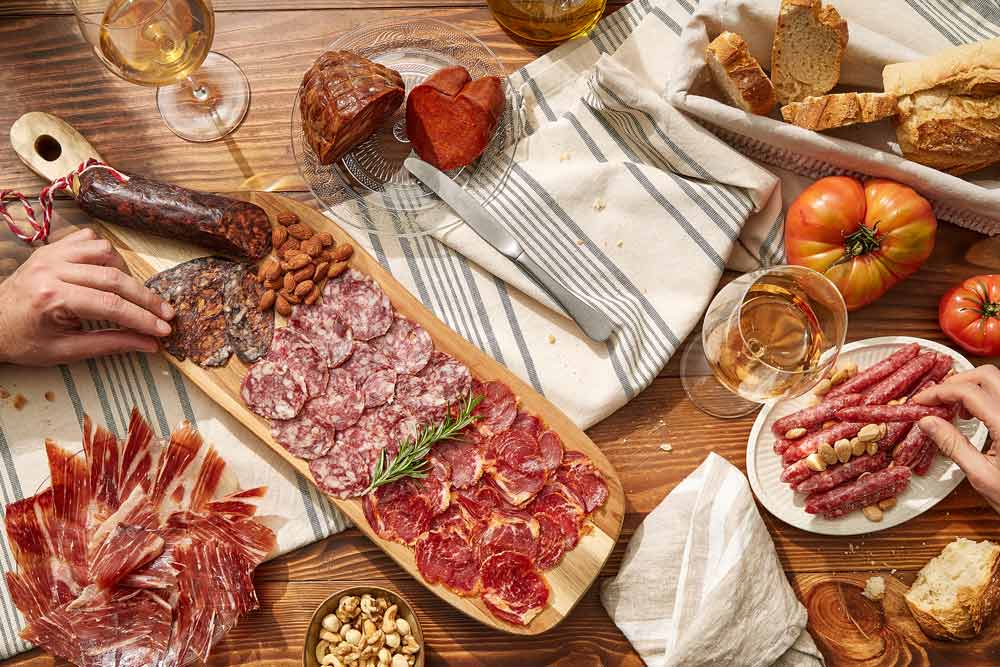.png.transform/rendition-xs/image_image%20(1).png)
Go-To Guide for the Ultimate Spanish Pantry
Spanish cuisine is known worldwide for its colorful collection of tapas, paellas, meats, and cheeses—the perfect complements to the country’s flourishing wine culture. With over 400 native grape varieties and 69 official wine regions, Spain’s multifaceted terroir offers something for absolutely everyone.

The key to the perfect Spanish food and wine pairing? A well-stocked pantry. And while words like chorizo and manchego have made their way into any budding chef’s vocabulary, here are a few lesser-known items deserving of shelfspace in any gourmand’s despensa—alongside classic Spanish wine recommendations.
Rioja (Reds) + Marcona Almonds
The red wines of northern Spain’s Rioja region are known for being bold and juicy, and are generally made from blends of Tempranillo and Garnacha plus local grapes like Graciano and Mazuelo. They pair perfectly with Marcona almonds, which are unique to Spain. These nuts are rounder and lightly sweeter than usual almonds and have a softer texture. This pairing is a must-try for charcuterie boards!
Priorat (Reds) + Pimentón (Spanish paprika)
Located just south of Barcelona, Priorat’s wines are known for being complex, silky, and rich, and are made mainly from Garnacha with a sprinkle of Cariñena, Syrah or other local grapes. Their flavor profile of black fruit and herbaceous smoke pairs perfectly with pimentón. Made from crushed and dried peppers, this Spanish version of paprika can range from sweet to spicy and even has various DOs (Denominations of Origin) for its peppers. Because Priorat reds can stand up to a little spice, pimentón on meats, seafood or even eggs makes a fun and intriguing wine pairing.
Ribera del Duero (Red) + Jamón Serrano or Ibérico (Ham)
Ribera reds come from just south of Rioja and are made from Tinto Fino (which is just a local nickname for Tempranillo). The tannins in these wines are well supported by the umami found in dry cured meats like Jamón Serrano or Ibérico, which are named after the pig breeds from which they’re made. Ibérico ham is a particular delicacy, being cured for two to four years. This pairing is best enjoyed as part of a meat board or with ham-wrapped melon or even asparagus.
Cava (Sparkling) + Guindilla amd Piquillo Peppers
The famous sparkling wine of Spain, Cava is usually produced from Macabeu, Parellada, Xarello, Pinot Noir, or Chardonnay, and is made in both rosé and brut styles. The quality and ageworthiness of Cava can be comparable to Champagne—but usually at a fraction of the price. In fact, when aged, Cava can take on a bready flavor that cuts perfectly through the light spice of Guindilla and Piquillo peppers from the Basque region. These peppers can be pickled or fresh and are known for their elongated shape and light sweet heat. Cava can be enjoyed with them as a stuffed pepper tapa or with the peppers in more complex dishes of shrimp or rice.
Sherry (Fortified) + Sherry vinegar and anchovies
Sherry hails from Andalucía in southern Spain and is made mostly of Pedro Ximénez, Palomino, Muscat of Alexandria, and some lesser known varietals. It’s a fortified wine that comes in a variety of styles ranging from fruity and nutty (like a Manzanilla or Fino style) to honied and raisined (like a Moscatel or Palo Cortado style). Diverse types of sherry can pair with any boquerones (cooked and vingared tapa made from anchovies or zucchini). The dryness of the sherry cuts through the vinegar to leave pleasant salinity.
Albariño (White) + Manchego Cheese
Albariño is a grape variety local to the north Atlantic coast of Spain in Galicia. It’s known for its floral citrus flavours with a distinct minerality and acidity. This acidity pairs perfectly with Manchego’s nuttiness and sweeter side. A sheep's cheese coming from central Spain, Manchego can be enjoyed with Albariño as part of a cheese board or even in nex-level grilled cheese.
Godello (White) + Spanish Olive Oil
Also local to Galicia, Godello is a lesser known but equally zippy white wine. With flavours of lemon and minerals, its bright taste goes well with light olive oil. In fact, Spain produces around 50% of the world’s olive oil. Spanish olive oil tends to be more golden in color vs. its greener Italian counterparts, and offers a fruitier, nuttier flavor.

